Business & the Business Environment
VerifiedAdded on 2023/01/19
|15
|4164
|100
AI Summary
This report discusses the different types and purposes of organisations in the business environment, including public, private, and voluntary sectors. It explains the size and scope of various organisations and the relationship between different organisational functions. It also identifies the positive and negative impacts of the macro environment on business operations.
Contribute Materials
Your contribution can guide someone’s learning journey. Share your
documents today.
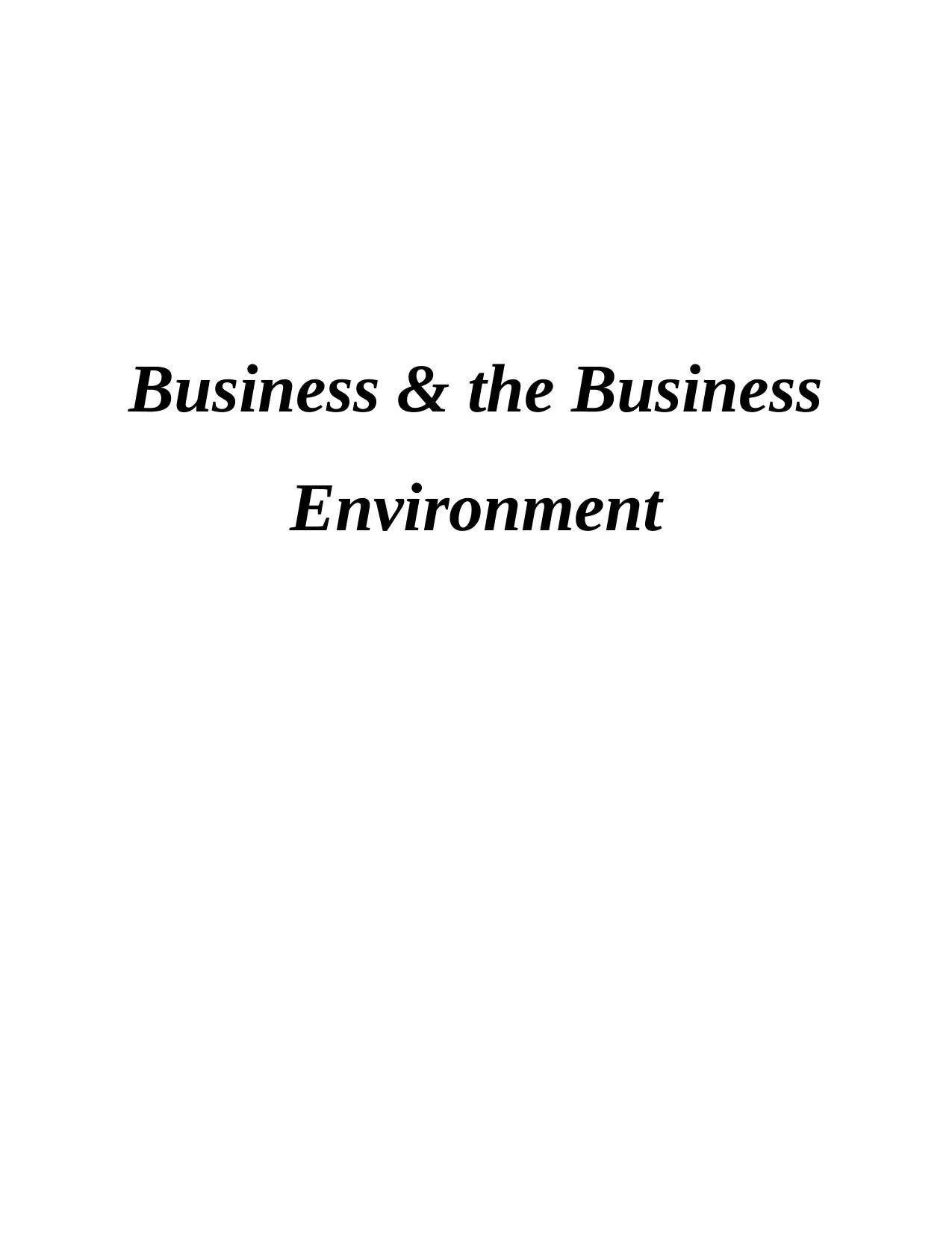
Business & the Business
Environment
Environment
Secure Best Marks with AI Grader
Need help grading? Try our AI Grader for instant feedback on your assignments.
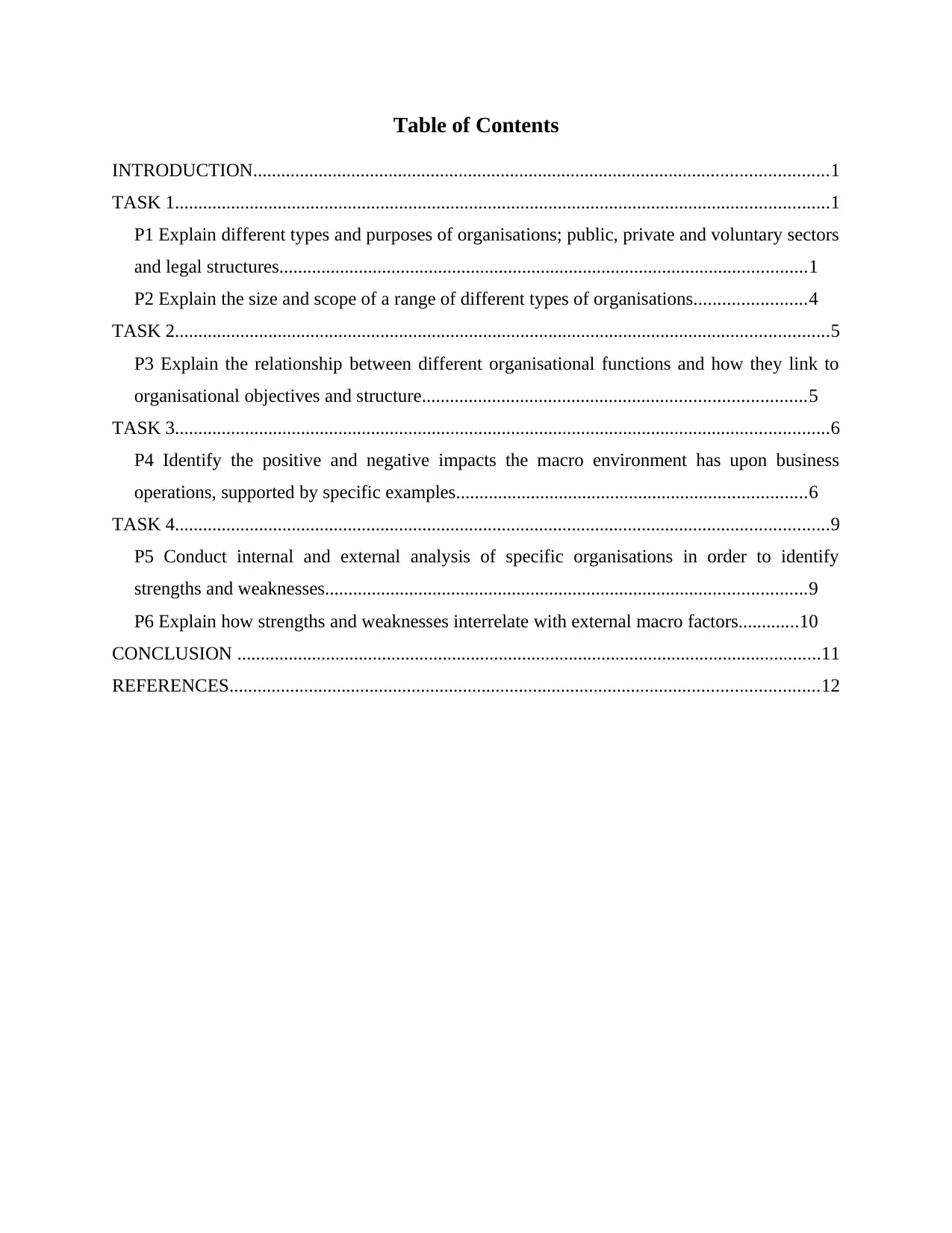
Table of Contents
INTRODUCTION...........................................................................................................................1
TASK 1............................................................................................................................................1
P1 Explain different types and purposes of organisations; public, private and voluntary sectors
and legal structures.................................................................................................................1
P2 Explain the size and scope of a range of different types of organisations........................4
TASK 2............................................................................................................................................5
P3 Explain the relationship between different organisational functions and how they link to
organisational objectives and structure..................................................................................5
TASK 3............................................................................................................................................6
P4 Identify the positive and negative impacts the macro environment has upon business
operations, supported by specific examples...........................................................................6
TASK 4............................................................................................................................................9
P5 Conduct internal and external analysis of specific organisations in order to identify
strengths and weaknesses.......................................................................................................9
P6 Explain how strengths and weaknesses interrelate with external macro factors.............10
CONCLUSION .............................................................................................................................11
REFERENCES..............................................................................................................................12
INTRODUCTION...........................................................................................................................1
TASK 1............................................................................................................................................1
P1 Explain different types and purposes of organisations; public, private and voluntary sectors
and legal structures.................................................................................................................1
P2 Explain the size and scope of a range of different types of organisations........................4
TASK 2............................................................................................................................................5
P3 Explain the relationship between different organisational functions and how they link to
organisational objectives and structure..................................................................................5
TASK 3............................................................................................................................................6
P4 Identify the positive and negative impacts the macro environment has upon business
operations, supported by specific examples...........................................................................6
TASK 4............................................................................................................................................9
P5 Conduct internal and external analysis of specific organisations in order to identify
strengths and weaknesses.......................................................................................................9
P6 Explain how strengths and weaknesses interrelate with external macro factors.............10
CONCLUSION .............................................................................................................................11
REFERENCES..............................................................................................................................12

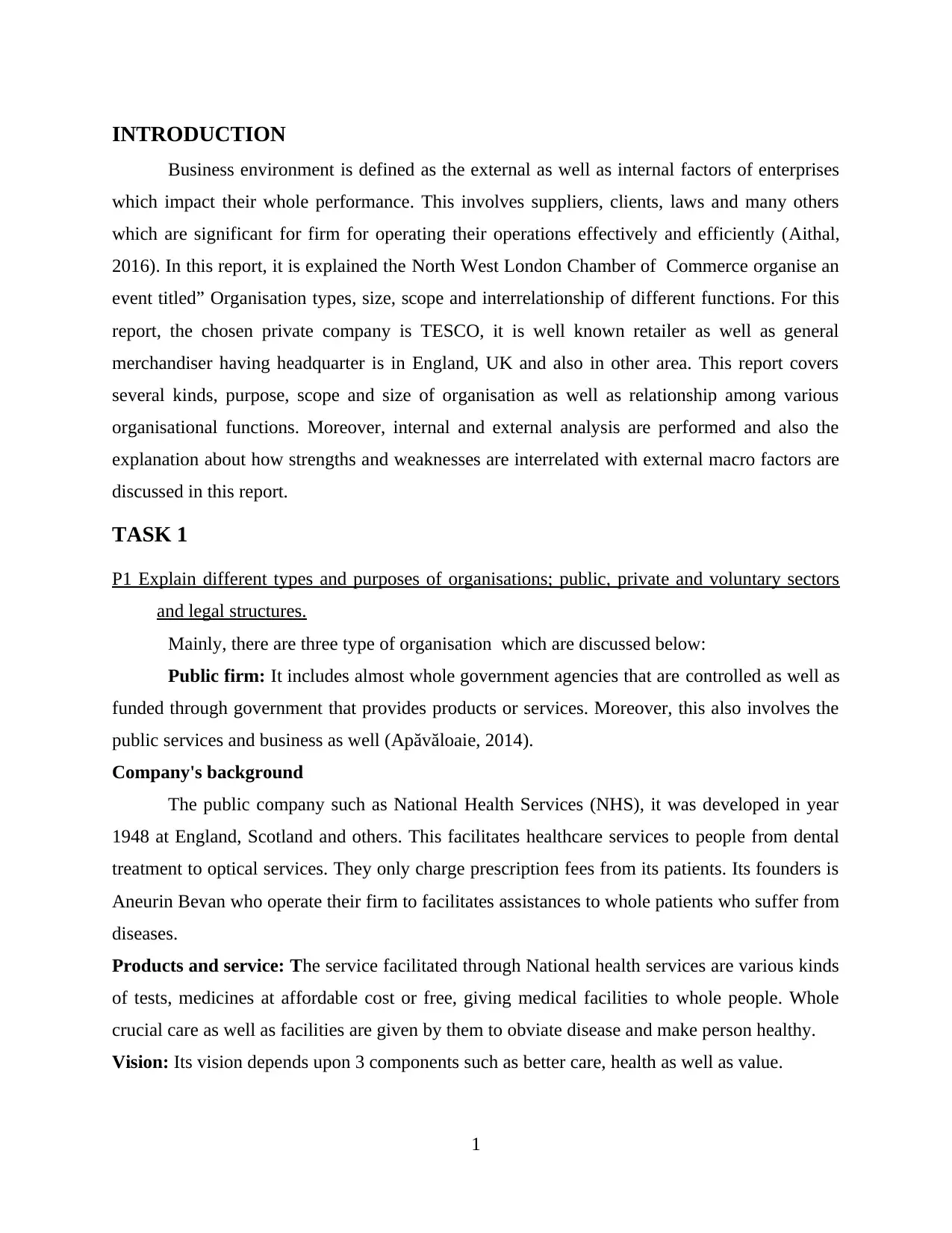
INTRODUCTION
Business environment is defined as the external as well as internal factors of enterprises
which impact their whole performance. This involves suppliers, clients, laws and many others
which are significant for firm for operating their operations effectively and efficiently (Aithal,
2016). In this report, it is explained the North West London Chamber of Commerce organise an
event titled” Organisation types, size, scope and interrelationship of different functions. For this
report, the chosen private company is TESCO, it is well known retailer as well as general
merchandiser having headquarter is in England, UK and also in other area. This report covers
several kinds, purpose, scope and size of organisation as well as relationship among various
organisational functions. Moreover, internal and external analysis are performed and also the
explanation about how strengths and weaknesses are interrelated with external macro factors are
discussed in this report.
TASK 1
P1 Explain different types and purposes of organisations; public, private and voluntary sectors
and legal structures.
Mainly, there are three type of organisation which are discussed below:
Public firm: It includes almost whole government agencies that are controlled as well as
funded through government that provides products or services. Moreover, this also involves the
public services and business as well (Apăvăloaie, 2014).
Company's background
The public company such as National Health Services (NHS), it was developed in year
1948 at England, Scotland and others. This facilitates healthcare services to people from dental
treatment to optical services. They only charge prescription fees from its patients. Its founders is
Aneurin Bevan who operate their firm to facilitates assistances to whole patients who suffer from
diseases.
Products and service: The service facilitated through National health services are various kinds
of tests, medicines at affordable cost or free, giving medical facilities to whole people. Whole
crucial care as well as facilities are given by them to obviate disease and make person healthy.
Vision: Its vision depends upon 3 components such as better care, health as well as value.
1
Business environment is defined as the external as well as internal factors of enterprises
which impact their whole performance. This involves suppliers, clients, laws and many others
which are significant for firm for operating their operations effectively and efficiently (Aithal,
2016). In this report, it is explained the North West London Chamber of Commerce organise an
event titled” Organisation types, size, scope and interrelationship of different functions. For this
report, the chosen private company is TESCO, it is well known retailer as well as general
merchandiser having headquarter is in England, UK and also in other area. This report covers
several kinds, purpose, scope and size of organisation as well as relationship among various
organisational functions. Moreover, internal and external analysis are performed and also the
explanation about how strengths and weaknesses are interrelated with external macro factors are
discussed in this report.
TASK 1
P1 Explain different types and purposes of organisations; public, private and voluntary sectors
and legal structures.
Mainly, there are three type of organisation which are discussed below:
Public firm: It includes almost whole government agencies that are controlled as well as
funded through government that provides products or services. Moreover, this also involves the
public services and business as well (Apăvăloaie, 2014).
Company's background
The public company such as National Health Services (NHS), it was developed in year
1948 at England, Scotland and others. This facilitates healthcare services to people from dental
treatment to optical services. They only charge prescription fees from its patients. Its founders is
Aneurin Bevan who operate their firm to facilitates assistances to whole patients who suffer from
diseases.
Products and service: The service facilitated through National health services are various kinds
of tests, medicines at affordable cost or free, giving medical facilities to whole people. Whole
crucial care as well as facilities are given by them to obviate disease and make person healthy.
Vision: Its vision depends upon 3 components such as better care, health as well as value.
1
Secure Best Marks with AI Grader
Need help grading? Try our AI Grader for instant feedback on your assignments.
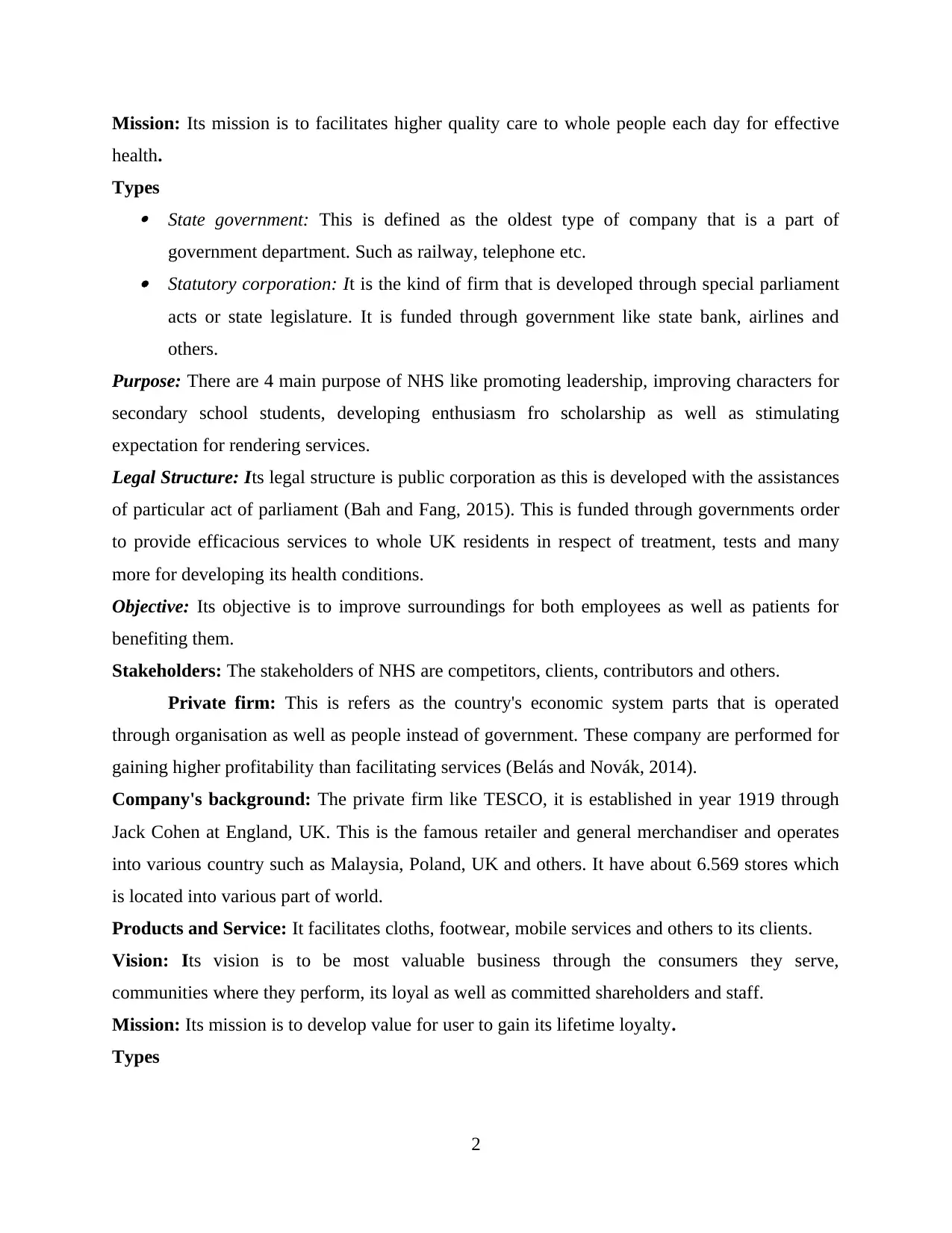
Mission: Its mission is to facilitates higher quality care to whole people each day for effective
health.
Types State government: This is defined as the oldest type of company that is a part of
government department. Such as railway, telephone etc. Statutory corporation: It is the kind of firm that is developed through special parliament
acts or state legislature. It is funded through government like state bank, airlines and
others.
Purpose: There are 4 main purpose of NHS like promoting leadership, improving characters for
secondary school students, developing enthusiasm fro scholarship as well as stimulating
expectation for rendering services.
Legal Structure: Its legal structure is public corporation as this is developed with the assistances
of particular act of parliament (Bah and Fang, 2015). This is funded through governments order
to provide efficacious services to whole UK residents in respect of treatment, tests and many
more for developing its health conditions.
Objective: Its objective is to improve surroundings for both employees as well as patients for
benefiting them.
Stakeholders: The stakeholders of NHS are competitors, clients, contributors and others.
Private firm: This is refers as the country's economic system parts that is operated
through organisation as well as people instead of government. These company are performed for
gaining higher profitability than facilitating services (Belás and Novák, 2014).
Company's background: The private firm like TESCO, it is established in year 1919 through
Jack Cohen at England, UK. This is the famous retailer and general merchandiser and operates
into various country such as Malaysia, Poland, UK and others. It have about 6.569 stores which
is located into various part of world.
Products and Service: It facilitates cloths, footwear, mobile services and others to its clients.
Vision: Its vision is to be most valuable business through the consumers they serve,
communities where they perform, its loyal as well as committed shareholders and staff.
Mission: Its mission is to develop value for user to gain its lifetime loyalty.
Types
2
health.
Types State government: This is defined as the oldest type of company that is a part of
government department. Such as railway, telephone etc. Statutory corporation: It is the kind of firm that is developed through special parliament
acts or state legislature. It is funded through government like state bank, airlines and
others.
Purpose: There are 4 main purpose of NHS like promoting leadership, improving characters for
secondary school students, developing enthusiasm fro scholarship as well as stimulating
expectation for rendering services.
Legal Structure: Its legal structure is public corporation as this is developed with the assistances
of particular act of parliament (Bah and Fang, 2015). This is funded through governments order
to provide efficacious services to whole UK residents in respect of treatment, tests and many
more for developing its health conditions.
Objective: Its objective is to improve surroundings for both employees as well as patients for
benefiting them.
Stakeholders: The stakeholders of NHS are competitors, clients, contributors and others.
Private firm: This is refers as the country's economic system parts that is operated
through organisation as well as people instead of government. These company are performed for
gaining higher profitability than facilitating services (Belás and Novák, 2014).
Company's background: The private firm like TESCO, it is established in year 1919 through
Jack Cohen at England, UK. This is the famous retailer and general merchandiser and operates
into various country such as Malaysia, Poland, UK and others. It have about 6.569 stores which
is located into various part of world.
Products and Service: It facilitates cloths, footwear, mobile services and others to its clients.
Vision: Its vision is to be most valuable business through the consumers they serve,
communities where they perform, its loyal as well as committed shareholders and staff.
Mission: Its mission is to develop value for user to gain its lifetime loyalty.
Types
2
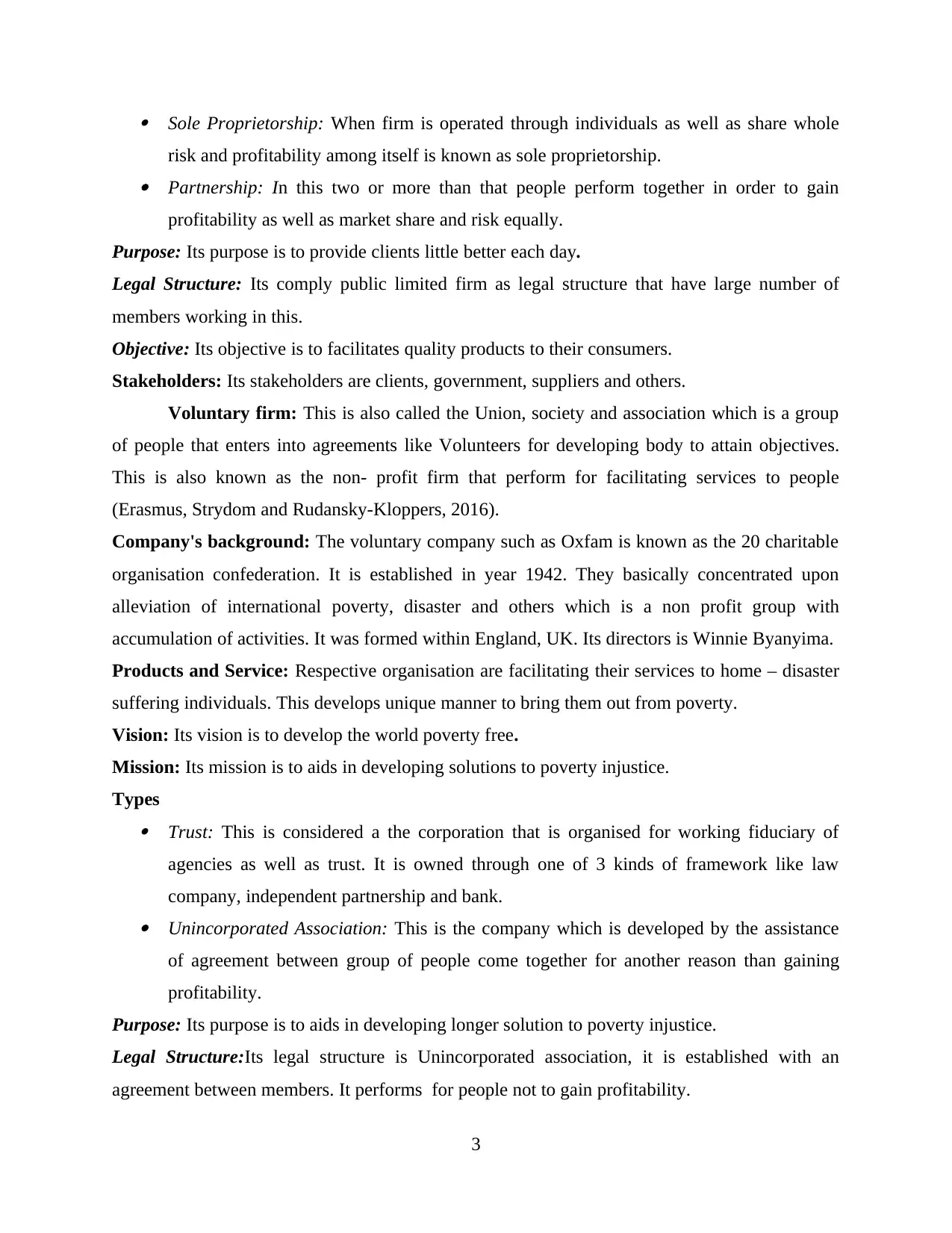
Sole Proprietorship: When firm is operated through individuals as well as share whole
risk and profitability among itself is known as sole proprietorship. Partnership: In this two or more than that people perform together in order to gain
profitability as well as market share and risk equally.
Purpose: Its purpose is to provide clients little better each day.
Legal Structure: Its comply public limited firm as legal structure that have large number of
members working in this.
Objective: Its objective is to facilitates quality products to their consumers.
Stakeholders: Its stakeholders are clients, government, suppliers and others.
Voluntary firm: This is also called the Union, society and association which is a group
of people that enters into agreements like Volunteers for developing body to attain objectives.
This is also known as the non- profit firm that perform for facilitating services to people
(Erasmus, Strydom and Rudansky-Kloppers, 2016).
Company's background: The voluntary company such as Oxfam is known as the 20 charitable
organisation confederation. It is established in year 1942. They basically concentrated upon
alleviation of international poverty, disaster and others which is a non profit group with
accumulation of activities. It was formed within England, UK. Its directors is Winnie Byanyima.
Products and Service: Respective organisation are facilitating their services to home – disaster
suffering individuals. This develops unique manner to bring them out from poverty.
Vision: Its vision is to develop the world poverty free.
Mission: Its mission is to aids in developing solutions to poverty injustice.
Types Trust: This is considered a the corporation that is organised for working fiduciary of
agencies as well as trust. It is owned through one of 3 kinds of framework like law
company, independent partnership and bank. Unincorporated Association: This is the company which is developed by the assistance
of agreement between group of people come together for another reason than gaining
profitability.
Purpose: Its purpose is to aids in developing longer solution to poverty injustice.
Legal Structure:Its legal structure is Unincorporated association, it is established with an
agreement between members. It performs for people not to gain profitability.
3
risk and profitability among itself is known as sole proprietorship. Partnership: In this two or more than that people perform together in order to gain
profitability as well as market share and risk equally.
Purpose: Its purpose is to provide clients little better each day.
Legal Structure: Its comply public limited firm as legal structure that have large number of
members working in this.
Objective: Its objective is to facilitates quality products to their consumers.
Stakeholders: Its stakeholders are clients, government, suppliers and others.
Voluntary firm: This is also called the Union, society and association which is a group
of people that enters into agreements like Volunteers for developing body to attain objectives.
This is also known as the non- profit firm that perform for facilitating services to people
(Erasmus, Strydom and Rudansky-Kloppers, 2016).
Company's background: The voluntary company such as Oxfam is known as the 20 charitable
organisation confederation. It is established in year 1942. They basically concentrated upon
alleviation of international poverty, disaster and others which is a non profit group with
accumulation of activities. It was formed within England, UK. Its directors is Winnie Byanyima.
Products and Service: Respective organisation are facilitating their services to home – disaster
suffering individuals. This develops unique manner to bring them out from poverty.
Vision: Its vision is to develop the world poverty free.
Mission: Its mission is to aids in developing solutions to poverty injustice.
Types Trust: This is considered a the corporation that is organised for working fiduciary of
agencies as well as trust. It is owned through one of 3 kinds of framework like law
company, independent partnership and bank. Unincorporated Association: This is the company which is developed by the assistance
of agreement between group of people come together for another reason than gaining
profitability.
Purpose: Its purpose is to aids in developing longer solution to poverty injustice.
Legal Structure:Its legal structure is Unincorporated association, it is established with an
agreement between members. It performs for people not to gain profitability.
3
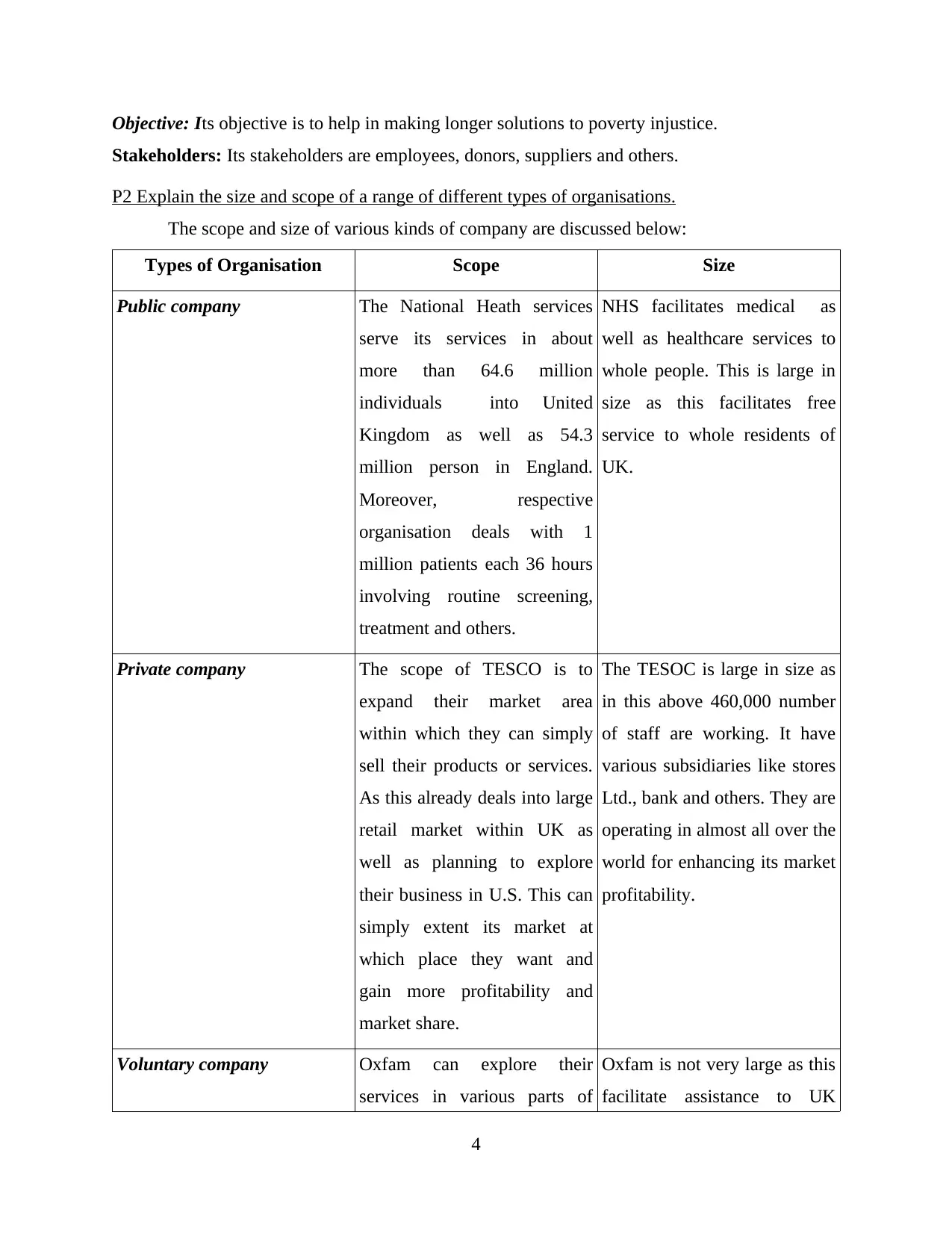
Objective: Its objective is to help in making longer solutions to poverty injustice.
Stakeholders: Its stakeholders are employees, donors, suppliers and others.
P2 Explain the size and scope of a range of different types of organisations.
The scope and size of various kinds of company are discussed below:
Types of Organisation Scope Size
Public company The National Heath services
serve its services in about
more than 64.6 million
individuals into United
Kingdom as well as 54.3
million person in England.
Moreover, respective
organisation deals with 1
million patients each 36 hours
involving routine screening,
treatment and others.
NHS facilitates medical as
well as healthcare services to
whole people. This is large in
size as this facilitates free
service to whole residents of
UK.
Private company The scope of TESCO is to
expand their market area
within which they can simply
sell their products or services.
As this already deals into large
retail market within UK as
well as planning to explore
their business in U.S. This can
simply extent its market at
which place they want and
gain more profitability and
market share.
The TESOC is large in size as
in this above 460,000 number
of staff are working. It have
various subsidiaries like stores
Ltd., bank and others. They are
operating in almost all over the
world for enhancing its market
profitability.
Voluntary company Oxfam can explore their
services in various parts of
Oxfam is not very large as this
facilitate assistance to UK
4
Stakeholders: Its stakeholders are employees, donors, suppliers and others.
P2 Explain the size and scope of a range of different types of organisations.
The scope and size of various kinds of company are discussed below:
Types of Organisation Scope Size
Public company The National Heath services
serve its services in about
more than 64.6 million
individuals into United
Kingdom as well as 54.3
million person in England.
Moreover, respective
organisation deals with 1
million patients each 36 hours
involving routine screening,
treatment and others.
NHS facilitates medical as
well as healthcare services to
whole people. This is large in
size as this facilitates free
service to whole residents of
UK.
Private company The scope of TESCO is to
expand their market area
within which they can simply
sell their products or services.
As this already deals into large
retail market within UK as
well as planning to explore
their business in U.S. This can
simply extent its market at
which place they want and
gain more profitability and
market share.
The TESOC is large in size as
in this above 460,000 number
of staff are working. It have
various subsidiaries like stores
Ltd., bank and others. They are
operating in almost all over the
world for enhancing its market
profitability.
Voluntary company Oxfam can explore their
services in various parts of
Oxfam is not very large as this
facilitate assistance to UK
4
Paraphrase This Document
Need a fresh take? Get an instant paraphrase of this document with our AI Paraphraser
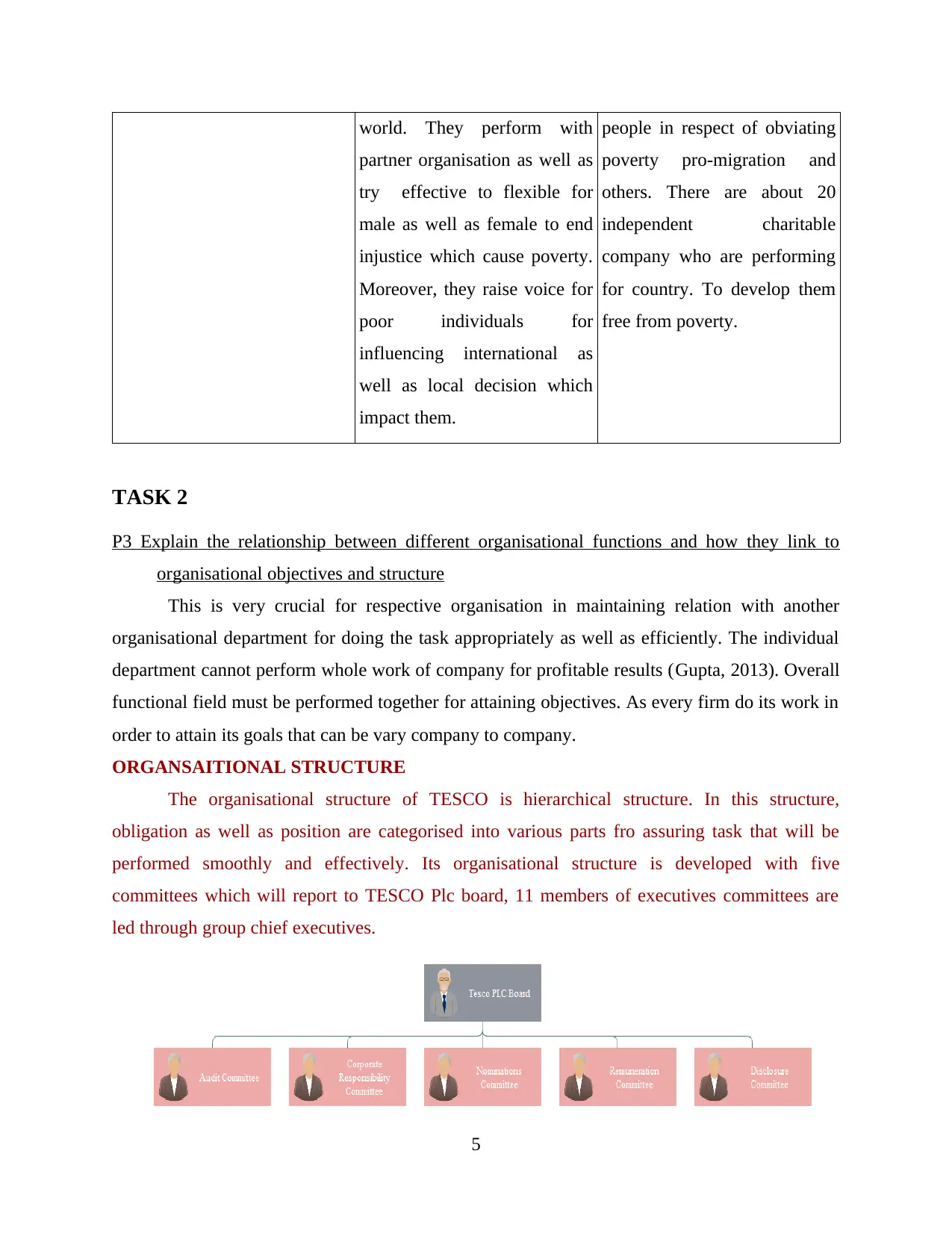
world. They perform with
partner organisation as well as
try effective to flexible for
male as well as female to end
injustice which cause poverty.
Moreover, they raise voice for
poor individuals for
influencing international as
well as local decision which
impact them.
people in respect of obviating
poverty pro-migration and
others. There are about 20
independent charitable
company who are performing
for country. To develop them
free from poverty.
TASK 2
P3 Explain the relationship between different organisational functions and how they link to
organisational objectives and structure
This is very crucial for respective organisation in maintaining relation with another
organisational department for doing the task appropriately as well as efficiently. The individual
department cannot perform whole work of company for profitable results (Gupta, 2013). Overall
functional field must be performed together for attaining objectives. As every firm do its work in
order to attain its goals that can be vary company to company.
ORGANSAITIONAL STRUCTURE
The organisational structure of TESCO is hierarchical structure. In this structure,
obligation as well as position are categorised into various parts fro assuring task that will be
performed smoothly and effectively. Its organisational structure is developed with five
committees which will report to TESCO Plc board, 11 members of executives committees are
led through group chief executives.
5
partner organisation as well as
try effective to flexible for
male as well as female to end
injustice which cause poverty.
Moreover, they raise voice for
poor individuals for
influencing international as
well as local decision which
impact them.
people in respect of obviating
poverty pro-migration and
others. There are about 20
independent charitable
company who are performing
for country. To develop them
free from poverty.
TASK 2
P3 Explain the relationship between different organisational functions and how they link to
organisational objectives and structure
This is very crucial for respective organisation in maintaining relation with another
organisational department for doing the task appropriately as well as efficiently. The individual
department cannot perform whole work of company for profitable results (Gupta, 2013). Overall
functional field must be performed together for attaining objectives. As every firm do its work in
order to attain its goals that can be vary company to company.
ORGANSAITIONAL STRUCTURE
The organisational structure of TESCO is hierarchical structure. In this structure,
obligation as well as position are categorised into various parts fro assuring task that will be
performed smoothly and effectively. Its organisational structure is developed with five
committees which will report to TESCO Plc board, 11 members of executives committees are
led through group chief executives.
5
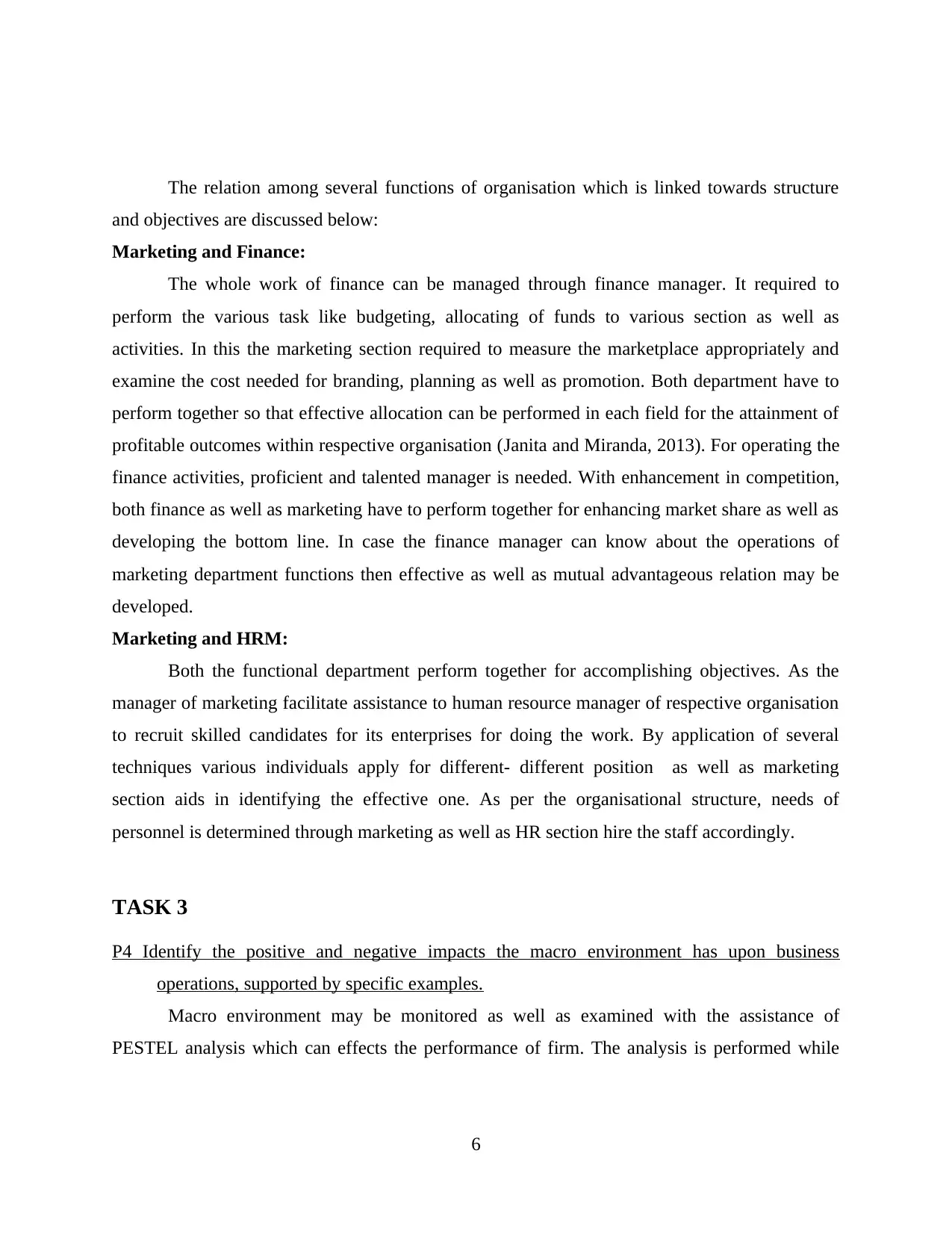
The relation among several functions of organisation which is linked towards structure
and objectives are discussed below:
Marketing and Finance:
The whole work of finance can be managed through finance manager. It required to
perform the various task like budgeting, allocating of funds to various section as well as
activities. In this the marketing section required to measure the marketplace appropriately and
examine the cost needed for branding, planning as well as promotion. Both department have to
perform together so that effective allocation can be performed in each field for the attainment of
profitable outcomes within respective organisation (Janita and Miranda, 2013). For operating the
finance activities, proficient and talented manager is needed. With enhancement in competition,
both finance as well as marketing have to perform together for enhancing market share as well as
developing the bottom line. In case the finance manager can know about the operations of
marketing department functions then effective as well as mutual advantageous relation may be
developed.
Marketing and HRM:
Both the functional department perform together for accomplishing objectives. As the
manager of marketing facilitate assistance to human resource manager of respective organisation
to recruit skilled candidates for its enterprises for doing the work. By application of several
techniques various individuals apply for different- different position as well as marketing
section aids in identifying the effective one. As per the organisational structure, needs of
personnel is determined through marketing as well as HR section hire the staff accordingly.
TASK 3
P4 Identify the positive and negative impacts the macro environment has upon business
operations, supported by specific examples.
Macro environment may be monitored as well as examined with the assistance of
PESTEL analysis which can effects the performance of firm. The analysis is performed while
6
and objectives are discussed below:
Marketing and Finance:
The whole work of finance can be managed through finance manager. It required to
perform the various task like budgeting, allocating of funds to various section as well as
activities. In this the marketing section required to measure the marketplace appropriately and
examine the cost needed for branding, planning as well as promotion. Both department have to
perform together so that effective allocation can be performed in each field for the attainment of
profitable outcomes within respective organisation (Janita and Miranda, 2013). For operating the
finance activities, proficient and talented manager is needed. With enhancement in competition,
both finance as well as marketing have to perform together for enhancing market share as well as
developing the bottom line. In case the finance manager can know about the operations of
marketing department functions then effective as well as mutual advantageous relation may be
developed.
Marketing and HRM:
Both the functional department perform together for accomplishing objectives. As the
manager of marketing facilitate assistance to human resource manager of respective organisation
to recruit skilled candidates for its enterprises for doing the work. By application of several
techniques various individuals apply for different- different position as well as marketing
section aids in identifying the effective one. As per the organisational structure, needs of
personnel is determined through marketing as well as HR section hire the staff accordingly.
TASK 3
P4 Identify the positive and negative impacts the macro environment has upon business
operations, supported by specific examples.
Macro environment may be monitored as well as examined with the assistance of
PESTEL analysis which can effects the performance of firm. The analysis is performed while
6
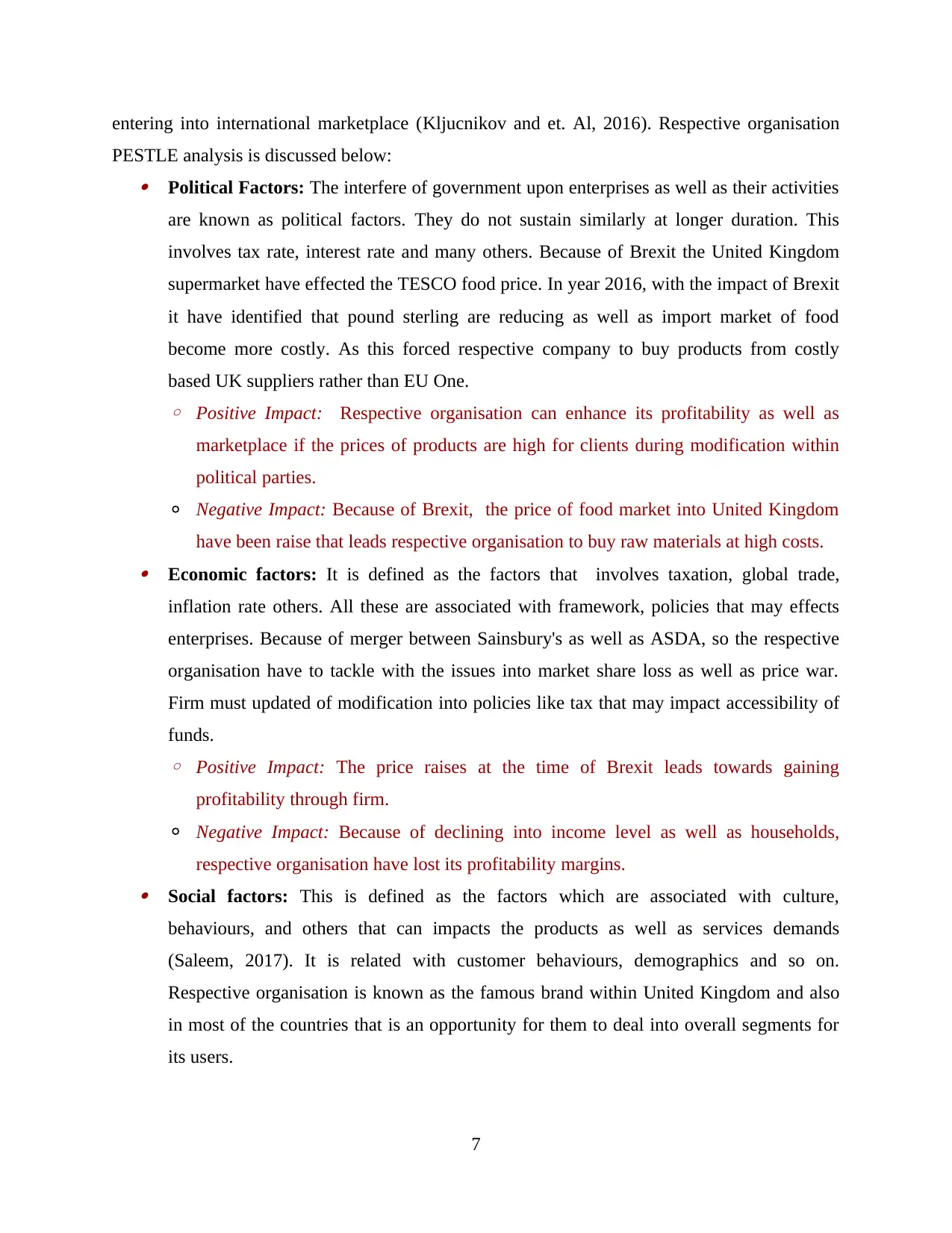
entering into international marketplace (Kljucnikov and et. Al, 2016). Respective organisation
PESTLE analysis is discussed below: Political Factors: The interfere of government upon enterprises as well as their activities
are known as political factors. They do not sustain similarly at longer duration. This
involves tax rate, interest rate and many others. Because of Brexit the United Kingdom
supermarket have effected the TESCO food price. In year 2016, with the impact of Brexit
it have identified that pound sterling are reducing as well as import market of food
become more costly. As this forced respective company to buy products from costly
based UK suppliers rather than EU One.
◦ Positive Impact: Respective organisation can enhance its profitability as well as
marketplace if the prices of products are high for clients during modification within
political parties.
◦ Negative Impact: Because of Brexit, the price of food market into United Kingdom
have been raise that leads respective organisation to buy raw materials at high costs. Economic factors: It is defined as the factors that involves taxation, global trade,
inflation rate others. All these are associated with framework, policies that may effects
enterprises. Because of merger between Sainsbury's as well as ASDA, so the respective
organisation have to tackle with the issues into market share loss as well as price war.
Firm must updated of modification into policies like tax that may impact accessibility of
funds.
◦ Positive Impact: The price raises at the time of Brexit leads towards gaining
profitability through firm.
◦ Negative Impact: Because of declining into income level as well as households,
respective organisation have lost its profitability margins. Social factors: This is defined as the factors which are associated with culture,
behaviours, and others that can impacts the products as well as services demands
(Saleem, 2017). It is related with customer behaviours, demographics and so on.
Respective organisation is known as the famous brand within United Kingdom and also
in most of the countries that is an opportunity for them to deal into overall segments for
its users.
7
PESTLE analysis is discussed below: Political Factors: The interfere of government upon enterprises as well as their activities
are known as political factors. They do not sustain similarly at longer duration. This
involves tax rate, interest rate and many others. Because of Brexit the United Kingdom
supermarket have effected the TESCO food price. In year 2016, with the impact of Brexit
it have identified that pound sterling are reducing as well as import market of food
become more costly. As this forced respective company to buy products from costly
based UK suppliers rather than EU One.
◦ Positive Impact: Respective organisation can enhance its profitability as well as
marketplace if the prices of products are high for clients during modification within
political parties.
◦ Negative Impact: Because of Brexit, the price of food market into United Kingdom
have been raise that leads respective organisation to buy raw materials at high costs. Economic factors: It is defined as the factors that involves taxation, global trade,
inflation rate others. All these are associated with framework, policies that may effects
enterprises. Because of merger between Sainsbury's as well as ASDA, so the respective
organisation have to tackle with the issues into market share loss as well as price war.
Firm must updated of modification into policies like tax that may impact accessibility of
funds.
◦ Positive Impact: The price raises at the time of Brexit leads towards gaining
profitability through firm.
◦ Negative Impact: Because of declining into income level as well as households,
respective organisation have lost its profitability margins. Social factors: This is defined as the factors which are associated with culture,
behaviours, and others that can impacts the products as well as services demands
(Saleem, 2017). It is related with customer behaviours, demographics and so on.
Respective organisation is known as the famous brand within United Kingdom and also
in most of the countries that is an opportunity for them to deal into overall segments for
its users.
7
Secure Best Marks with AI Grader
Need help grading? Try our AI Grader for instant feedback on your assignments.
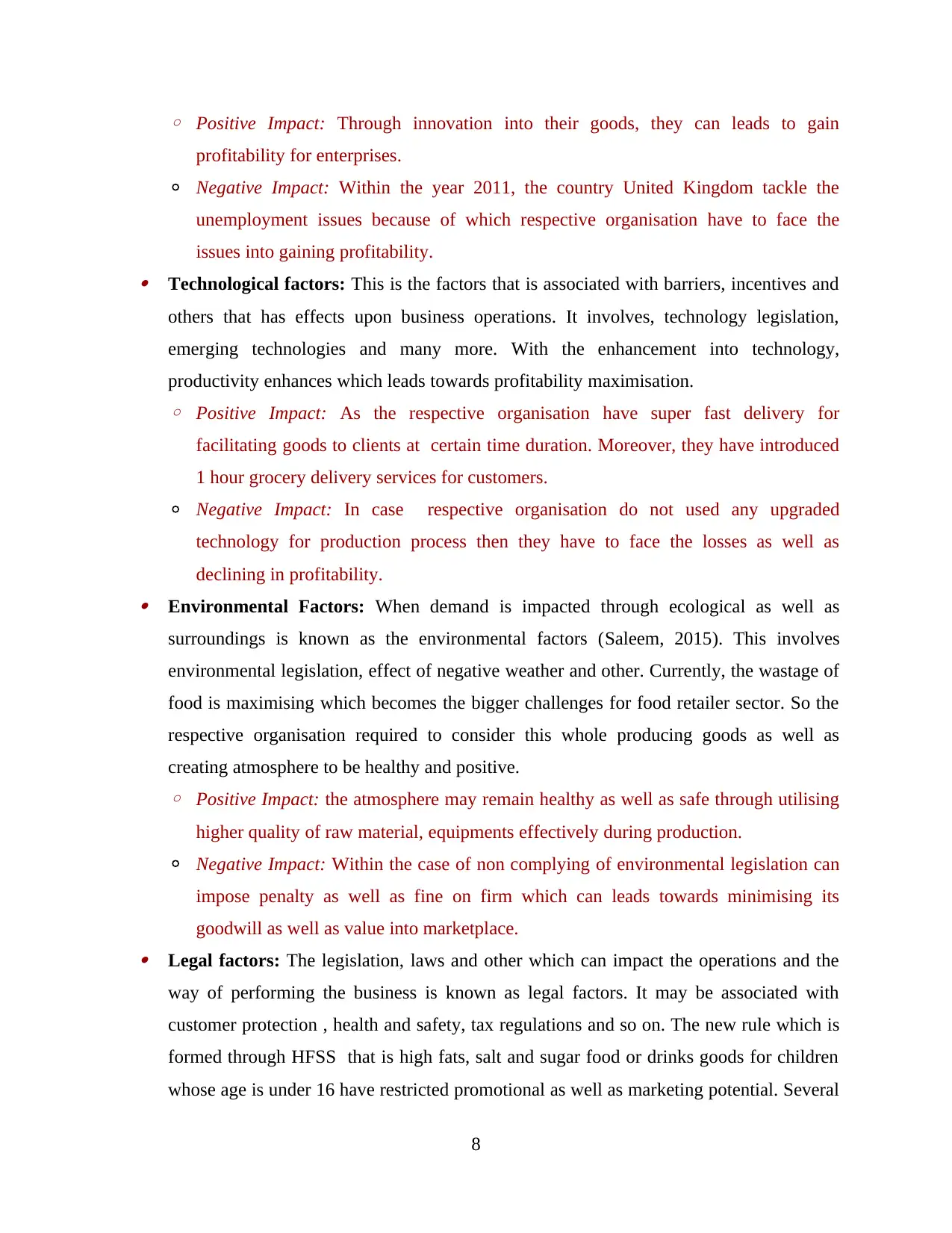
◦ Positive Impact: Through innovation into their goods, they can leads to gain
profitability for enterprises.
◦ Negative Impact: Within the year 2011, the country United Kingdom tackle the
unemployment issues because of which respective organisation have to face the
issues into gaining profitability. Technological factors: This is the factors that is associated with barriers, incentives and
others that has effects upon business operations. It involves, technology legislation,
emerging technologies and many more. With the enhancement into technology,
productivity enhances which leads towards profitability maximisation.
◦ Positive Impact: As the respective organisation have super fast delivery for
facilitating goods to clients at certain time duration. Moreover, they have introduced
1 hour grocery delivery services for customers.
◦ Negative Impact: In case respective organisation do not used any upgraded
technology for production process then they have to face the losses as well as
declining in profitability. Environmental Factors: When demand is impacted through ecological as well as
surroundings is known as the environmental factors (Saleem, 2015). This involves
environmental legislation, effect of negative weather and other. Currently, the wastage of
food is maximising which becomes the bigger challenges for food retailer sector. So the
respective organisation required to consider this whole producing goods as well as
creating atmosphere to be healthy and positive.
◦ Positive Impact: the atmosphere may remain healthy as well as safe through utilising
higher quality of raw material, equipments effectively during production.
◦ Negative Impact: Within the case of non complying of environmental legislation can
impose penalty as well as fine on firm which can leads towards minimising its
goodwill as well as value into marketplace. Legal factors: The legislation, laws and other which can impact the operations and the
way of performing the business is known as legal factors. It may be associated with
customer protection , health and safety, tax regulations and so on. The new rule which is
formed through HFSS that is high fats, salt and sugar food or drinks goods for children
whose age is under 16 have restricted promotional as well as marketing potential. Several
8
profitability for enterprises.
◦ Negative Impact: Within the year 2011, the country United Kingdom tackle the
unemployment issues because of which respective organisation have to face the
issues into gaining profitability. Technological factors: This is the factors that is associated with barriers, incentives and
others that has effects upon business operations. It involves, technology legislation,
emerging technologies and many more. With the enhancement into technology,
productivity enhances which leads towards profitability maximisation.
◦ Positive Impact: As the respective organisation have super fast delivery for
facilitating goods to clients at certain time duration. Moreover, they have introduced
1 hour grocery delivery services for customers.
◦ Negative Impact: In case respective organisation do not used any upgraded
technology for production process then they have to face the losses as well as
declining in profitability. Environmental Factors: When demand is impacted through ecological as well as
surroundings is known as the environmental factors (Saleem, 2015). This involves
environmental legislation, effect of negative weather and other. Currently, the wastage of
food is maximising which becomes the bigger challenges for food retailer sector. So the
respective organisation required to consider this whole producing goods as well as
creating atmosphere to be healthy and positive.
◦ Positive Impact: the atmosphere may remain healthy as well as safe through utilising
higher quality of raw material, equipments effectively during production.
◦ Negative Impact: Within the case of non complying of environmental legislation can
impose penalty as well as fine on firm which can leads towards minimising its
goodwill as well as value into marketplace. Legal factors: The legislation, laws and other which can impact the operations and the
way of performing the business is known as legal factors. It may be associated with
customer protection , health and safety, tax regulations and so on. The new rule which is
formed through HFSS that is high fats, salt and sugar food or drinks goods for children
whose age is under 16 have restricted promotional as well as marketing potential. Several
8
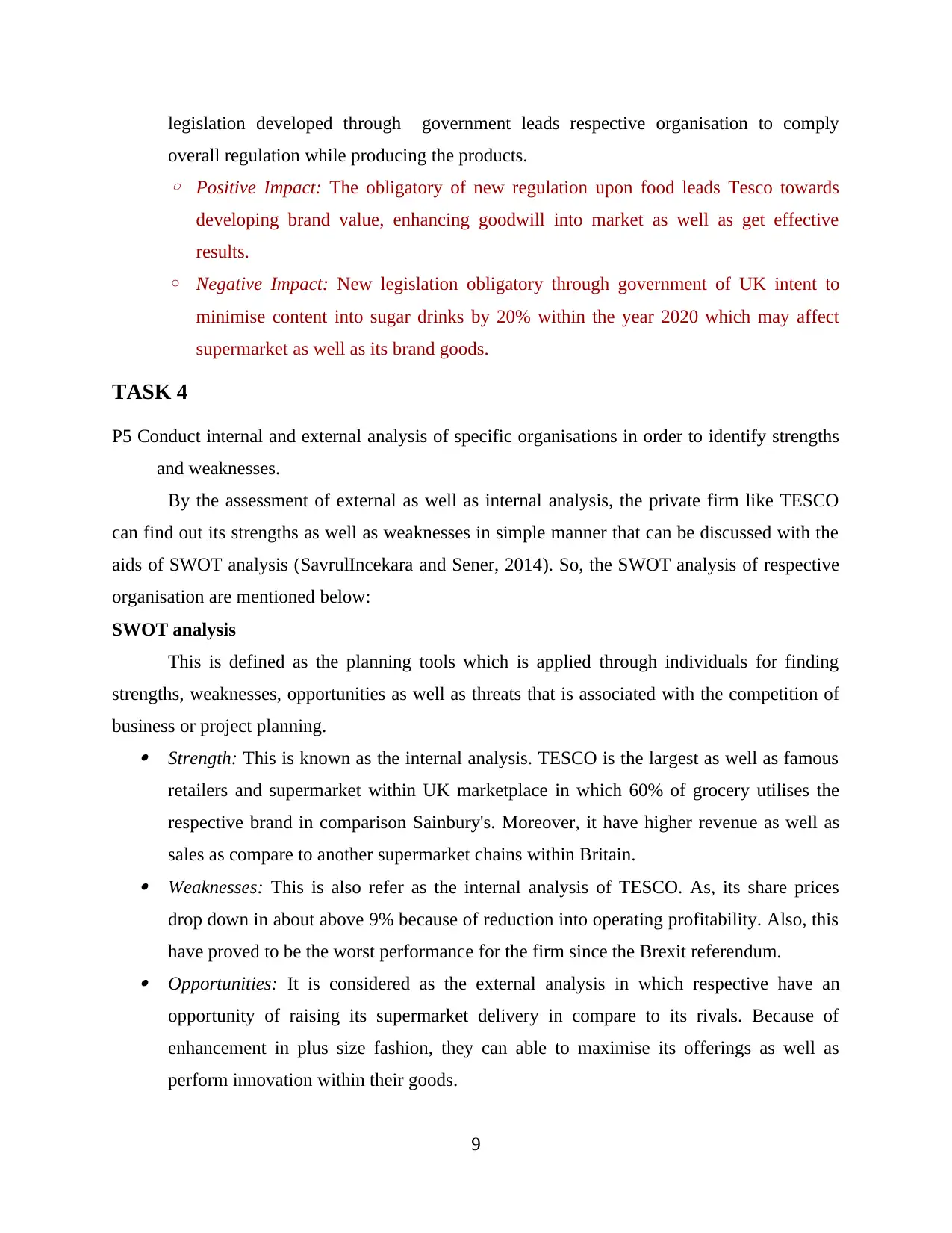
legislation developed through government leads respective organisation to comply
overall regulation while producing the products.
◦ Positive Impact: The obligatory of new regulation upon food leads Tesco towards
developing brand value, enhancing goodwill into market as well as get effective
results.
◦ Negative Impact: New legislation obligatory through government of UK intent to
minimise content into sugar drinks by 20% within the year 2020 which may affect
supermarket as well as its brand goods.
TASK 4
P5 Conduct internal and external analysis of specific organisations in order to identify strengths
and weaknesses.
By the assessment of external as well as internal analysis, the private firm like TESCO
can find out its strengths as well as weaknesses in simple manner that can be discussed with the
aids of SWOT analysis (SavrulIncekara and Sener, 2014). So, the SWOT analysis of respective
organisation are mentioned below:
SWOT analysis
This is defined as the planning tools which is applied through individuals for finding
strengths, weaknesses, opportunities as well as threats that is associated with the competition of
business or project planning. Strength: This is known as the internal analysis. TESCO is the largest as well as famous
retailers and supermarket within UK marketplace in which 60% of grocery utilises the
respective brand in comparison Sainbury's. Moreover, it have higher revenue as well as
sales as compare to another supermarket chains within Britain. Weaknesses: This is also refer as the internal analysis of TESCO. As, its share prices
drop down in about above 9% because of reduction into operating profitability. Also, this
have proved to be the worst performance for the firm since the Brexit referendum. Opportunities: It is considered as the external analysis in which respective have an
opportunity of raising its supermarket delivery in compare to its rivals. Because of
enhancement in plus size fashion, they can able to maximise its offerings as well as
perform innovation within their goods.
9
overall regulation while producing the products.
◦ Positive Impact: The obligatory of new regulation upon food leads Tesco towards
developing brand value, enhancing goodwill into market as well as get effective
results.
◦ Negative Impact: New legislation obligatory through government of UK intent to
minimise content into sugar drinks by 20% within the year 2020 which may affect
supermarket as well as its brand goods.
TASK 4
P5 Conduct internal and external analysis of specific organisations in order to identify strengths
and weaknesses.
By the assessment of external as well as internal analysis, the private firm like TESCO
can find out its strengths as well as weaknesses in simple manner that can be discussed with the
aids of SWOT analysis (SavrulIncekara and Sener, 2014). So, the SWOT analysis of respective
organisation are mentioned below:
SWOT analysis
This is defined as the planning tools which is applied through individuals for finding
strengths, weaknesses, opportunities as well as threats that is associated with the competition of
business or project planning. Strength: This is known as the internal analysis. TESCO is the largest as well as famous
retailers and supermarket within UK marketplace in which 60% of grocery utilises the
respective brand in comparison Sainbury's. Moreover, it have higher revenue as well as
sales as compare to another supermarket chains within Britain. Weaknesses: This is also refer as the internal analysis of TESCO. As, its share prices
drop down in about above 9% because of reduction into operating profitability. Also, this
have proved to be the worst performance for the firm since the Brexit referendum. Opportunities: It is considered as the external analysis in which respective have an
opportunity of raising its supermarket delivery in compare to its rivals. Because of
enhancement in plus size fashion, they can able to maximise its offerings as well as
perform innovation within their goods.
9
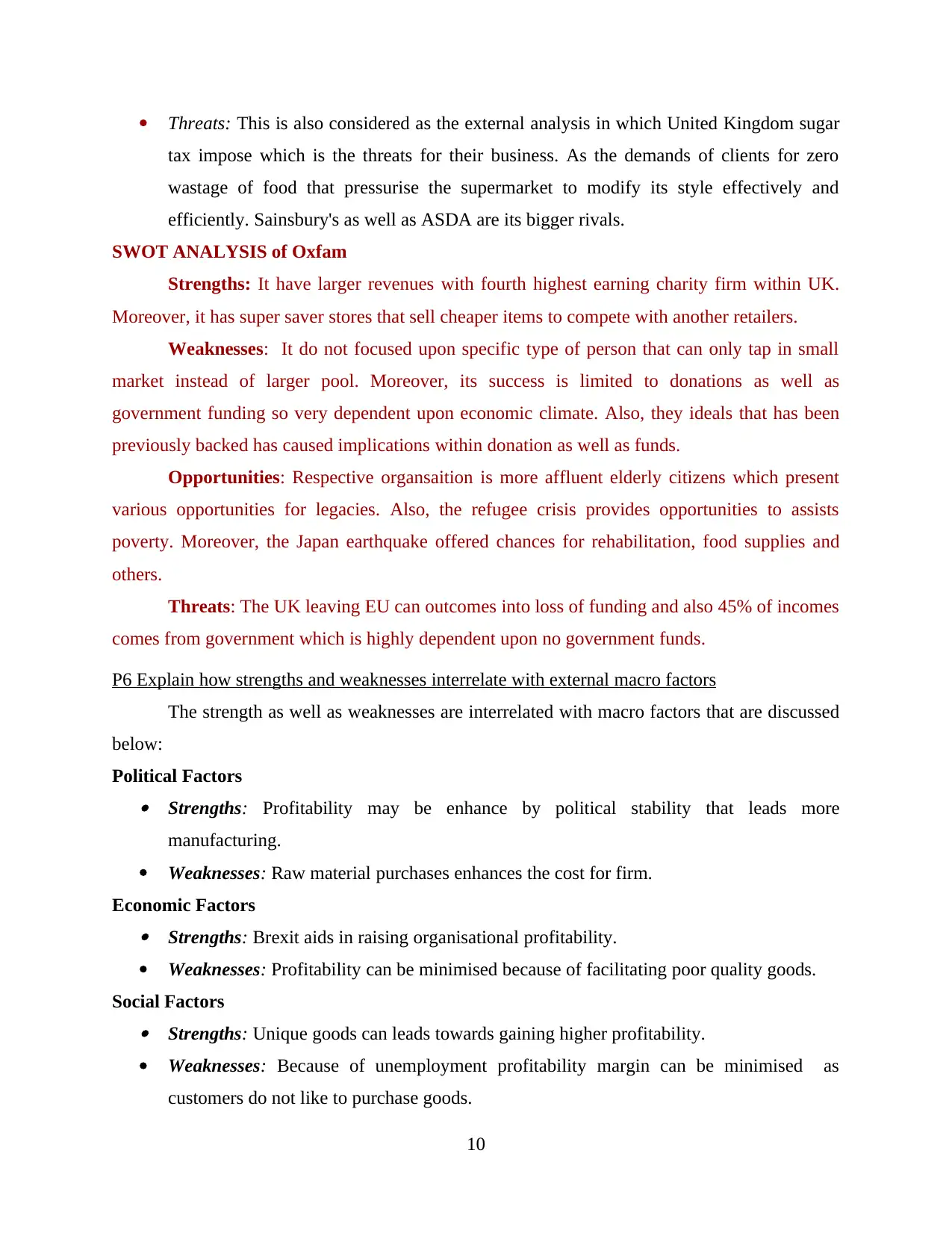
Threats: This is also considered as the external analysis in which United Kingdom sugar
tax impose which is the threats for their business. As the demands of clients for zero
wastage of food that pressurise the supermarket to modify its style effectively and
efficiently. Sainsbury's as well as ASDA are its bigger rivals.
SWOT ANALYSIS of Oxfam
Strengths: It have larger revenues with fourth highest earning charity firm within UK.
Moreover, it has super saver stores that sell cheaper items to compete with another retailers.
Weaknesses: It do not focused upon specific type of person that can only tap in small
market instead of larger pool. Moreover, its success is limited to donations as well as
government funding so very dependent upon economic climate. Also, they ideals that has been
previously backed has caused implications within donation as well as funds.
Opportunities: Respective organsaition is more affluent elderly citizens which present
various opportunities for legacies. Also, the refugee crisis provides opportunities to assists
poverty. Moreover, the Japan earthquake offered chances for rehabilitation, food supplies and
others.
Threats: The UK leaving EU can outcomes into loss of funding and also 45% of incomes
comes from government which is highly dependent upon no government funds.
P6 Explain how strengths and weaknesses interrelate with external macro factors
The strength as well as weaknesses are interrelated with macro factors that are discussed
below:
Political Factors Strengths: Profitability may be enhance by political stability that leads more
manufacturing.
Weaknesses: Raw material purchases enhances the cost for firm.
Economic Factors Strengths: Brexit aids in raising organisational profitability.
Weaknesses: Profitability can be minimised because of facilitating poor quality goods.
Social Factors Strengths: Unique goods can leads towards gaining higher profitability.
Weaknesses: Because of unemployment profitability margin can be minimised as
customers do not like to purchase goods.
10
tax impose which is the threats for their business. As the demands of clients for zero
wastage of food that pressurise the supermarket to modify its style effectively and
efficiently. Sainsbury's as well as ASDA are its bigger rivals.
SWOT ANALYSIS of Oxfam
Strengths: It have larger revenues with fourth highest earning charity firm within UK.
Moreover, it has super saver stores that sell cheaper items to compete with another retailers.
Weaknesses: It do not focused upon specific type of person that can only tap in small
market instead of larger pool. Moreover, its success is limited to donations as well as
government funding so very dependent upon economic climate. Also, they ideals that has been
previously backed has caused implications within donation as well as funds.
Opportunities: Respective organsaition is more affluent elderly citizens which present
various opportunities for legacies. Also, the refugee crisis provides opportunities to assists
poverty. Moreover, the Japan earthquake offered chances for rehabilitation, food supplies and
others.
Threats: The UK leaving EU can outcomes into loss of funding and also 45% of incomes
comes from government which is highly dependent upon no government funds.
P6 Explain how strengths and weaknesses interrelate with external macro factors
The strength as well as weaknesses are interrelated with macro factors that are discussed
below:
Political Factors Strengths: Profitability may be enhance by political stability that leads more
manufacturing.
Weaknesses: Raw material purchases enhances the cost for firm.
Economic Factors Strengths: Brexit aids in raising organisational profitability.
Weaknesses: Profitability can be minimised because of facilitating poor quality goods.
Social Factors Strengths: Unique goods can leads towards gaining higher profitability.
Weaknesses: Because of unemployment profitability margin can be minimised as
customers do not like to purchase goods.
10
Paraphrase This Document
Need a fresh take? Get an instant paraphrase of this document with our AI Paraphraser
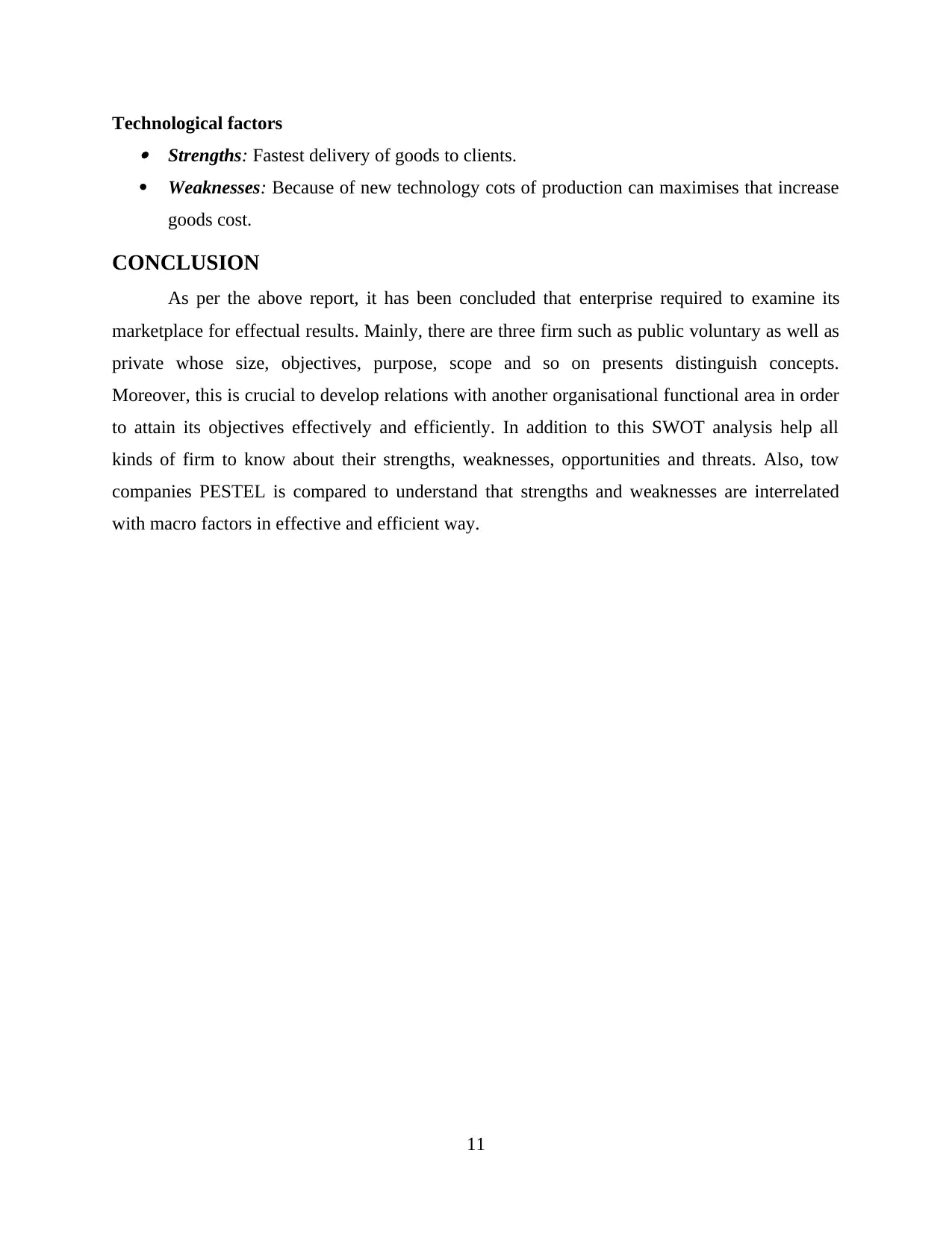
Technological factors Strengths: Fastest delivery of goods to clients.
Weaknesses: Because of new technology cots of production can maximises that increase
goods cost.
CONCLUSION
As per the above report, it has been concluded that enterprise required to examine its
marketplace for effectual results. Mainly, there are three firm such as public voluntary as well as
private whose size, objectives, purpose, scope and so on presents distinguish concepts.
Moreover, this is crucial to develop relations with another organisational functional area in order
to attain its objectives effectively and efficiently. In addition to this SWOT analysis help all
kinds of firm to know about their strengths, weaknesses, opportunities and threats. Also, tow
companies PESTEL is compared to understand that strengths and weaknesses are interrelated
with macro factors in effective and efficient way.
11
Weaknesses: Because of new technology cots of production can maximises that increase
goods cost.
CONCLUSION
As per the above report, it has been concluded that enterprise required to examine its
marketplace for effectual results. Mainly, there are three firm such as public voluntary as well as
private whose size, objectives, purpose, scope and so on presents distinguish concepts.
Moreover, this is crucial to develop relations with another organisational functional area in order
to attain its objectives effectively and efficiently. In addition to this SWOT analysis help all
kinds of firm to know about their strengths, weaknesses, opportunities and threats. Also, tow
companies PESTEL is compared to understand that strengths and weaknesses are interrelated
with macro factors in effective and efficient way.
11
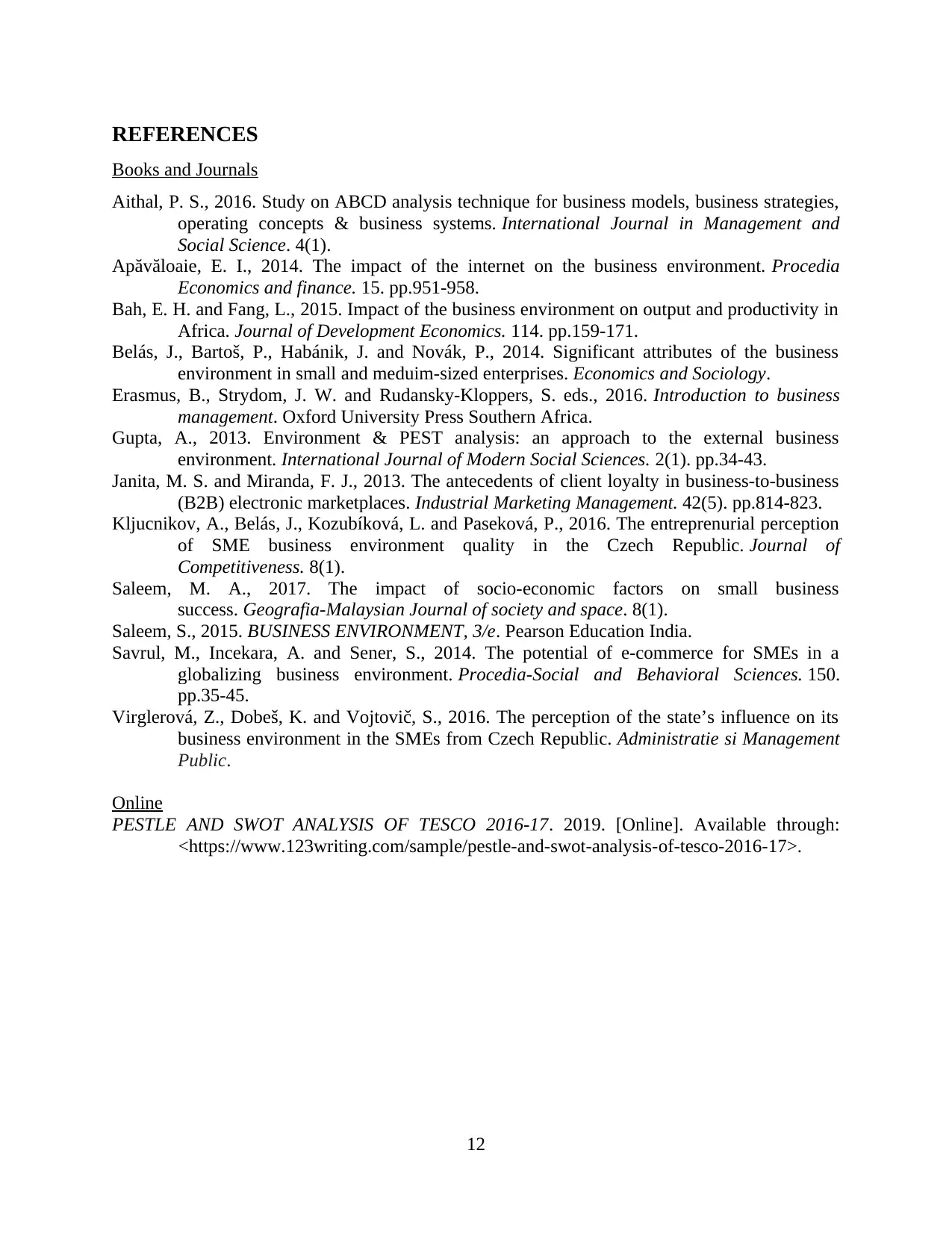
REFERENCES
Books and Journals
Aithal, P. S., 2016. Study on ABCD analysis technique for business models, business strategies,
operating concepts & business systems. International Journal in Management and
Social Science. 4(1).
Apăvăloaie, E. I., 2014. The impact of the internet on the business environment. Procedia
Economics and finance. 15. pp.951-958.
Bah, E. H. and Fang, L., 2015. Impact of the business environment on output and productivity in
Africa. Journal of Development Economics. 114. pp.159-171.
Belás, J., Bartoš, P., Habánik, J. and Novák, P., 2014. Significant attributes of the business
environment in small and meduim-sized enterprises. Economics and Sociology.
Erasmus, B., Strydom, J. W. and Rudansky-Kloppers, S. eds., 2016. Introduction to business
management. Oxford University Press Southern Africa.
Gupta, A., 2013. Environment & PEST analysis: an approach to the external business
environment. International Journal of Modern Social Sciences. 2(1). pp.34-43.
Janita, M. S. and Miranda, F. J., 2013. The antecedents of client loyalty in business-to-business
(B2B) electronic marketplaces. Industrial Marketing Management. 42(5). pp.814-823.
Kljucnikov, A., Belás, J., Kozubíková, L. and Paseková, P., 2016. The entreprenurial perception
of SME business environment quality in the Czech Republic. Journal of
Competitiveness. 8(1).
Saleem, M. A., 2017. The impact of socio-economic factors on small business
success. Geografia-Malaysian Journal of society and space. 8(1).
Saleem, S., 2015. BUSINESS ENVIRONMENT, 3/e. Pearson Education India.
Savrul, M., Incekara, A. and Sener, S., 2014. The potential of e-commerce for SMEs in a
globalizing business environment. Procedia-Social and Behavioral Sciences. 150.
pp.35-45.
Virglerová, Z., Dobeš, K. and Vojtovič, S., 2016. The perception of the state’s influence on its
business environment in the SMEs from Czech Republic. Administratie si Management
Public.
Online
PESTLE AND SWOT ANALYSIS OF TESCO 2016-17. 2019. [Online]. Available through:
<https://www.123writing.com/sample/pestle-and-swot-analysis-of-tesco-2016-17>.
12
Books and Journals
Aithal, P. S., 2016. Study on ABCD analysis technique for business models, business strategies,
operating concepts & business systems. International Journal in Management and
Social Science. 4(1).
Apăvăloaie, E. I., 2014. The impact of the internet on the business environment. Procedia
Economics and finance. 15. pp.951-958.
Bah, E. H. and Fang, L., 2015. Impact of the business environment on output and productivity in
Africa. Journal of Development Economics. 114. pp.159-171.
Belás, J., Bartoš, P., Habánik, J. and Novák, P., 2014. Significant attributes of the business
environment in small and meduim-sized enterprises. Economics and Sociology.
Erasmus, B., Strydom, J. W. and Rudansky-Kloppers, S. eds., 2016. Introduction to business
management. Oxford University Press Southern Africa.
Gupta, A., 2013. Environment & PEST analysis: an approach to the external business
environment. International Journal of Modern Social Sciences. 2(1). pp.34-43.
Janita, M. S. and Miranda, F. J., 2013. The antecedents of client loyalty in business-to-business
(B2B) electronic marketplaces. Industrial Marketing Management. 42(5). pp.814-823.
Kljucnikov, A., Belás, J., Kozubíková, L. and Paseková, P., 2016. The entreprenurial perception
of SME business environment quality in the Czech Republic. Journal of
Competitiveness. 8(1).
Saleem, M. A., 2017. The impact of socio-economic factors on small business
success. Geografia-Malaysian Journal of society and space. 8(1).
Saleem, S., 2015. BUSINESS ENVIRONMENT, 3/e. Pearson Education India.
Savrul, M., Incekara, A. and Sener, S., 2014. The potential of e-commerce for SMEs in a
globalizing business environment. Procedia-Social and Behavioral Sciences. 150.
pp.35-45.
Virglerová, Z., Dobeš, K. and Vojtovič, S., 2016. The perception of the state’s influence on its
business environment in the SMEs from Czech Republic. Administratie si Management
Public.
Online
PESTLE AND SWOT ANALYSIS OF TESCO 2016-17. 2019. [Online]. Available through:
<https://www.123writing.com/sample/pestle-and-swot-analysis-of-tesco-2016-17>.
12
1 out of 15
Related Documents
Your All-in-One AI-Powered Toolkit for Academic Success.
+13062052269
info@desklib.com
Available 24*7 on WhatsApp / Email
![[object Object]](/_next/static/media/star-bottom.7253800d.svg)
Unlock your academic potential
© 2024 | Zucol Services PVT LTD | All rights reserved.





